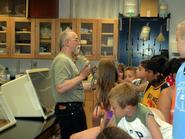
Four professors in the science department brought a bit of magic and wonder to the eyes of 90 New Hartford third-graders on June 2 during Hamilton College's annual Science Day. Geosciences Professor Cynthia Domack, Biology Professor David Gapp, Associate Professor of Chemistry Karen Brewer and Assistant Professor of Physics Seth Major planned half-hour demonstrations within each of their respective fields for the children, who traveled to Hamilton College from Myles Elementary School.
 |
|
Geology Professor Cynthia Domack
|
 |
| Associate Professor of Chemistry Karen Brewer |
 |
| Assistant Professor of Physics Seth Major |
In biology, Gapp brought out an array of reptiles to show the group, including an American alligator and snapping turtles, and told the children how and why these animals attack in the wild. Gapp explained how this alligator, only several feet long, was hatched in captivity, and its growth was intentionally stunted by limiting its food supply, whereas in the wild, these alligators grow to be at least 12 feet long and are therefore dangerous predators.
Each presentation was interactive, as all the professors asked the children questions relating to science, answered their questions, and included them as volunteers as well, much to their delight.
Mrs. Dellerba, one of the 3rd-grade teachers, said the children's opportunity to learn from the Hamilton College professors was a wonderful experience, and she expressed gratitude to the professors for hosting this day each year. "Last year, the Science Building was still being built so we couldn't come, and I was so disappointed because this is such a great experience for the kids," she said. "We are all very excited to be back this year."
-- by Katherine Trainor
Posted June 2, 2005
